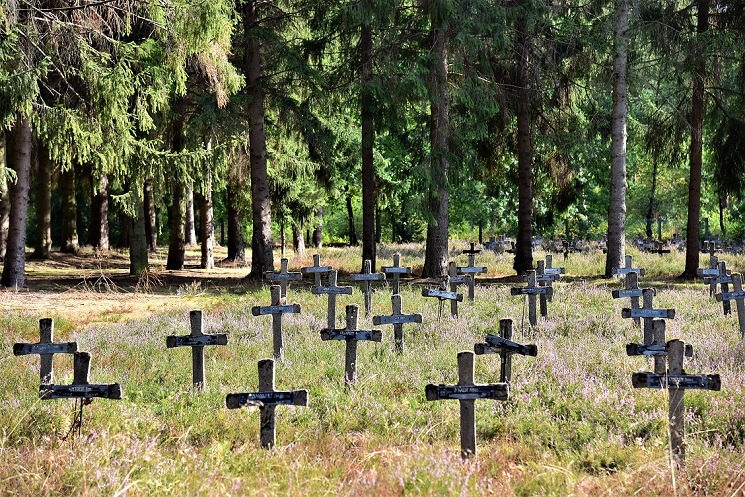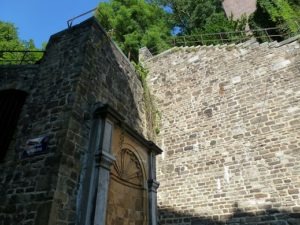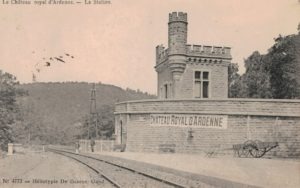Best-selling author Derek Blyth takes you to some places you might never have heard about, in a country almost no one knows.
The forgotten cemetery
PSYCHIATRIC HOSPITAL CEMETERY
The Flemish village of Oud-Rekem is one of the most beautiful spots in the country. Located next to the River Maas, not far from the Dutch border, it’s a perfectly-preserved village with cobbled streets, a moated castle, a town gate and a village square shaded by old trees.
It was once voted the most beautiful village in Flanders, but there is a secret spot hidden deep in the woods outside the village. It is not marked on local maps. And no one ever mentions it. It is a woodland cemetery where almost 2,000 patients from a psychiatric institution were buried between 1921 and 1981. And no one ever visits it.
The institution was based in Oud-Rekem’s enormous 16th-century castle. Acquired by the Belgian state in 1904, the building was turned into one of the country’s largest psychiatric institutions.
It takes a lot of searching to find the cemetery. It can be reached on foot from the village, but it is a long walk. It is easier to cycle along the Daalbroekstraat until you come to a modern psychiatric hospital signed OPZC, between cycle points 62 and 63. The cemetery is deep in the woods on the opposite side of the road. It really feels like a place they don’t want you to know about it.
Overgrown and deserted, it is perhaps one of the saddest places in Belgium. You cannot enter the cemetery but it is possible to stand at the rusty gates and see the rows of small crosses almost buried in the long grass. They mark the graves of psychiatric patients who were confined in the castle, forgotten by their friends and relatives, until they finally died. Look closely and you can see rosary beads hanging from some of the crosses. Maybe there are names. It is impossible to see.
Daalbroekstraat, Oud-Rekem
Limburg province
The lost railway
VENNBAHN
It’s possibly the strangest cycle trail in Belgium. The Vennbahn route in East Belgium follows an abandoned Belgian railway line partly created inside German territory at the end of the First World War.
Under the terms of the 1919 Treaty of Versailles, Germany was required to make reparations to Belgium. As well as making payments and handing over artworks, Germany had to hand over a 28.5-kilometre rail corridor between the villages of Kalterherberg and Raeren. The Belgian state received the land on which Kalterherberg station stands, but the village itself remained German, along with six German enclaves inside Belgium.
The Vennbahn railway used to run through the wild Hautes Fagnes region of Belgium carrying raw materials to Germany. It closed down in 2008, leaving behind abandoned tracks and empty stations. But an ambitious project was launched in 2013 to turn it into a cycling and walking trail.
The route, which includes the 1919 enclave, runs for 125 kilometres between Troisvierges in northern Luxembourg and Aachen in Germany. It takes you through deep pine woods and desolate stretches of the marshy Fagnes uplands. One of the most interesting sections – easily done in a day – runs from the abandoned station Sourbrodt Gare to the pretty valley town of Monschau in Germany.
It’s a fascinating route to explore. The border has virtually vanished, but you can still spot old border stones (marked P for Prussia on one side and B for Belgium on the other), abandoned road barriers and even the occasional unexpected Belgian flag next to the route.
The East Belgium tourist office has produced a useful map that marks the route, along with bike-friendly hotels, e-bike rental shops and repair spots along the way.
The secret orchard
LES COTEAUX DE LA CITADELLE
Next time you are in Liège, look out for the old house at Rue Pierreuse 38. Restored by the city in 2005, its ground floor was removed to allow access to the hill hidden behind the house. The architect Alain Richard carefully restored the upper floors while creating a new passage that runs straight under the house. It brings you out at the foot of a steep flight of steps leading up to an abandoned renaissance convent.
Most visitors to Liège never discover the orchards and meadows high above the city. Once planted with vines, this steeply sloping landscape known as les coteaux de la citadelle still has old fruit trees, grazing sheep and a few goats.
Until recently, it was difficult to reach the hill from the old town. You had to find the Impasse des Ursulines, an old staircase that runs behind the 17th-century Béguinage. Then you heaved up a series of narrow lanes and stone steps squeezed between ancient brick walls. Finally, at the top of the hill, you came to a gate leading into a wood known as the Bois des Mineurs. After all that effort, you just had to hope the gate wasn’t locked.
But then the city decided to open up two new routes to this secret spot. One goes through the courtyard of an old town house behind the law courts at Rue du Palais 60. The other, which opened in 2005, starts at the house on Rue Pierreuse.
Following the marked trails, you reach a series of viewpoints high above the old town. Looking down on the rooftops and spires, you can see the River Meuse winding through the city. Further away, the humpbacked shape of Calatrava’s soaring steel and glass Liège-Guillemins station glints in the sun.
There are five different trails that run across the hillside for a total of 13 kilometres. They are marked on the Sentiers des Coteaux map available from the tourist office. But you can just wander anywhere you want along this intriguing route.
The abandoned station
KING LEOPOLD’S STATION
One of the finest walks in the Ardennes follows the meandering River Lesse for about eight kilometres between Hoyet station and Gendron Gare. Along the way, you come across steep steps cut in the rock, iron ladders and narrow ledges. The railway runs close to the river, occasionally crossing impressive stone bridges or disappearing into tunnel entrances that look like castles.
The strangest sight along the route is a mysterious abandoned building next to the railway tracks. Designed to look like a medieval castle, it was built as a rural railway station by King Leopold II.
But why build a station in the middle of nowhere? Leopold had an ambitious plan. He wanted to create a grand hotel for the world’s élite in an area of the Ardennes known as “Little Switzerland”. He chose a site for his hotel near a mock mediaeval tower built by his father.
Named the Chateau Royal d’Ardenne, Leopold’s hotel was a massive turreted pile that opened its doors in 1891. The guests were collected at the station and taken in carriages up a steep curved road.
The hotel closed down in 1909 after Leopold died. After that, it went from one crisis to another. The building was damaged by troops during the First World War, then reopened after the war. It fell into enemy hands again in 1940 when the German general Joachim von Ribbentrop briefly used it as his headquarters.
The hotel struggled on for a few years after the Second World War, but its days were numbered and it closed in 1949. The vast building stood empty for almost 20 years until it was gutted by fire in 1968. The site is now occupied by a golf club, leaving just the original tower built by Leopold I and the overgrown station down by the river.
Hoyet, Namur province
The new neighbourhood
GROEN KWARTIER
The Groen Kwartier (Green Quarter) lies off the beaten track in Antwerp’s Berchem district. A restored 19th-century military hospital forms the hub of this new neighbourhood designed to promote sustainable living. The hospital buildings have been converted into apartments while the former chapel is occupied by Sergio Herman’s stunning restaurant The Jane.
You can spend the night here in a stunning new hotel that opened earlier this year in a former Augustinian convent. Restored by architect Vincent Van Duysen, the August has a cool minimalist look that preserves the original monastic calm.
Or you can come for the day to explore the industrial buzz of the Pakt quarter, next to the hospital. Like somewhere in Berlin, the site is a grungy mix of crumbling brick buildings, cobbled yards, old rusting machinery and rooftop greenhouses. Several start-up companies have based themselves here, along with health restaurant Racine, coffee shop Caffènation and beerhouse Spéciale Belge. Be sure to check opening times before you go as some places close at the weekend.





